FIAT DUCATO BASE CAMPER 2016 Owner handbook (in English)
Manufacturer: FIAT, Model Year: 2016, Model line: DUCATO BASE CAMPER, Model: FIAT DUCATO BASE CAMPER 2016Pages: 387, PDF Size: 20.76 MB
Page 171 of 387
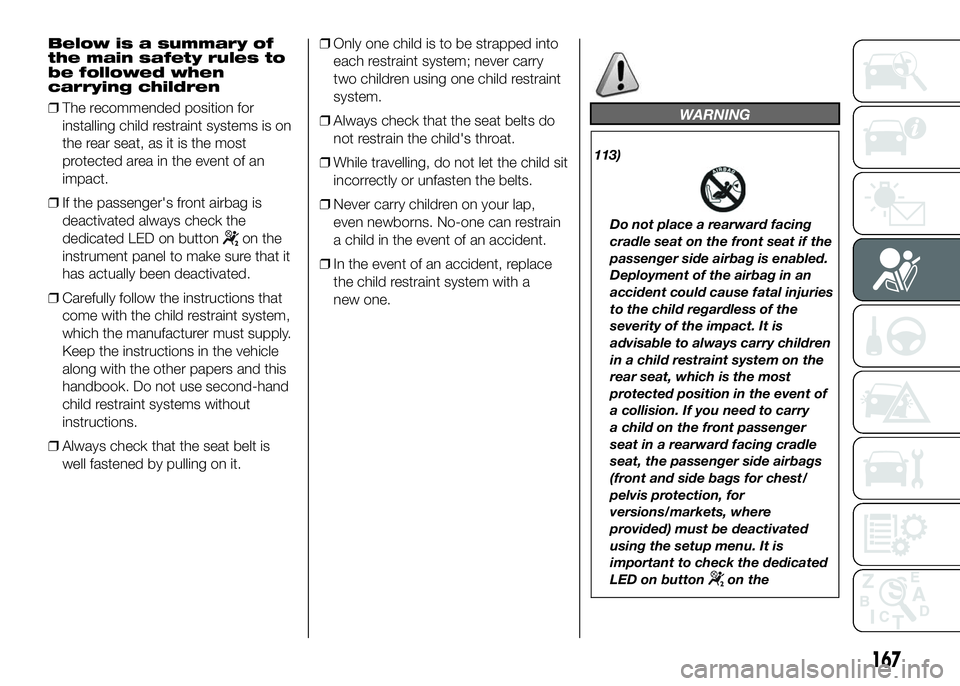
Below is a summary of
the main safety rules to
be followed when
carrying children
❒The recommended position for
installing child restraint systems is on
the rear seat, as it is the most
protected area in the event of an
impact.
❒If the passenger's front airbag is
deactivated always check the
dedicated LED on button
on the
instrument panel to make sure that it
has actually been deactivated.
❒Carefully follow the instructions that
come with the child restraint system,
which the manufacturer must supply.
Keep the instructions in the vehicle
along with the other papers and this
handbook. Do not use second-hand
child restraint systems without
instructions.
❒Always check that the seat belt is
well fastened by pulling on it.❒Only one child is to be strapped into
each restraint system; never carry
two children using one child restraint
system.
❒Always check that the seat belts do
not restrain the child's throat.
❒While travelling, do not let the child sit
incorrectly or unfasten the belts.
❒Never carry children on your lap,
even newborns. No-one can restrain
a child in the event of an accident.
❒In the event of an accident, replace
the child restraint system with a
new one.
WARNING
113)
Do not place a rearward facing
cradle seat on the front seat if the
passenger side airbag is enabled.
Deployment of the airbag in an
accident could cause fatal injuries
to the child regardless of the
severity of the impact. It is
advisable to always carry children
in a child restraint system on the
rear seat, which is the most
protected position in the event of
a collision. If you need to carry
a child on the front passenger
seat in a rearward facing cradle
seat, the passenger side airbags
(front and side bags for chest/
pelvis protection, for
versions/markets, where
provided) must be deactivated
using the setup menu. It is
important to check the dedicated
LED on button
on the
167
Page 172 of 387

instrument panel to make sure
that they are actually deactivated.
The passenger seat must also be
positioned back as far as possible
in order to avoid the child
restraint system from coming into
contact with the dashboard.
114) The figures are indicative and
for assembly purposes only. Fit
the child restraint system
according to the instructions,
which must be included.
115) Some child restraint systems
for weight group 0 and 1 have a
rear attachment to the car seat
belts and its own seat belts for
securing the child. Due to their
weight, they may be dangerous if
incorrectly mounted (e.g. if
fastened to the vehicle seat belts
placing a cushion in between).
Follow the assembly instructions
carefully.SETUP FOR
“UNIVERSAL
ISOFIX” CHILD
RESTRAINT SYSTEM
Provision has been made on the vehicle
to fit Universal Isofix child restraint
systems, a new European standardised
system for carrying children safely.
An example of a child restraint system
is shown in fig. 163.Due to its different attachment system,
the child restraint system must be
secured using the special lower metal
rings A fig. 164, positioned between
rear backrest and cushion. The upper
belt (provided with the child restraint
system) must be then secured to ring B
fig. 165 located in the lower part of
the seat. It is possible to have a mixed
assembly of traditional child restraint
systems and Universal Isofix ones.
163F1A0155164F1A0156
168
SAFETY
Page 173 of 387
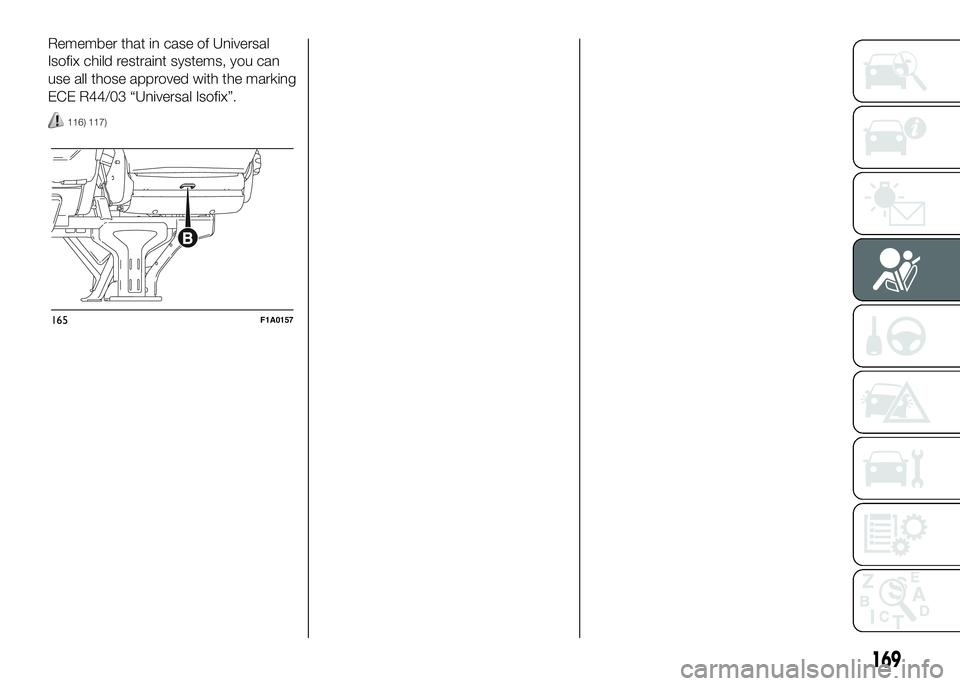
Remember that in case of Universal
Isofix child restraint systems, you can
use all those approved with the marking
ECE R44/03 “Universal Isofix”.
116) 117)
165F1A0157
169
Page 174 of 387
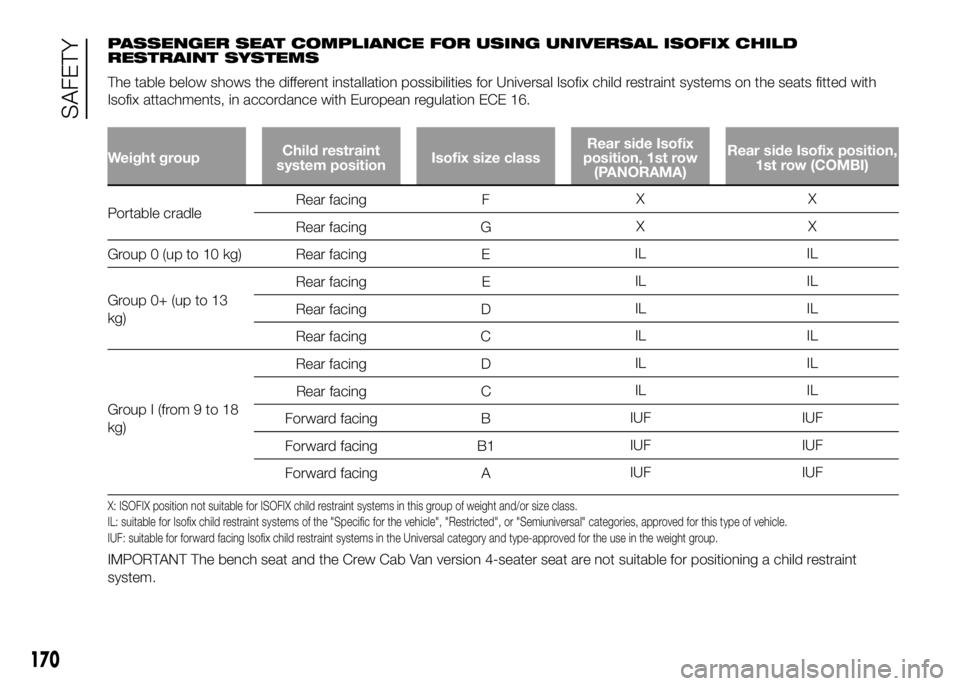
PASSENGER SEAT COMPLIANCE FOR USING UNIVERSAL ISOFIX CHILD
RESTRAINT SYSTEMS
The table below shows the different installation possibilities for Universal Isofix child restraint systems on the seats fitted with
Isofix attachments, in accordance with European regulation ECE 16.
Weight groupChild restraint
system positionIsofix size classRear side Isofix
position, 1st row
(PANORAMA)Rear side Isofix position,
1st row (COMBI)
Portable cradleRear
facing FXX
Rear facing GXX
Group 0 (up to 10 kg) Rear facing EIL IL
Group 0+ (up to 13
kg)Rear facing EIL IL
Rear facing DIL IL
Rear facing CIL IL
Group I (from 9 to 18
kg)Rear facing DIL IL
Rear facing CIL IL
Forward facing BIUF IUF
Forward facing B1IUF IUF
Forward facing AIUF IUF
X: ISOFIX position not suitable for ISOFIX child restraint systems in this group of weight and/or size class.
IL: suitable for Isofix child restraint systems of the "Specific for the vehicle", "Restricted", or "Semiuniversal" categories, approved for this type of vehicle.
IUF: suitable for forward facing Isofix child restraint systems in the Universal category and type-approved for the use in the weight group.
IMPORTANT The bench seat and the Crew Cab Van version 4-seater seat are not suitable for positioning a child restraint
system.
170
SAFETY
Page 175 of 387
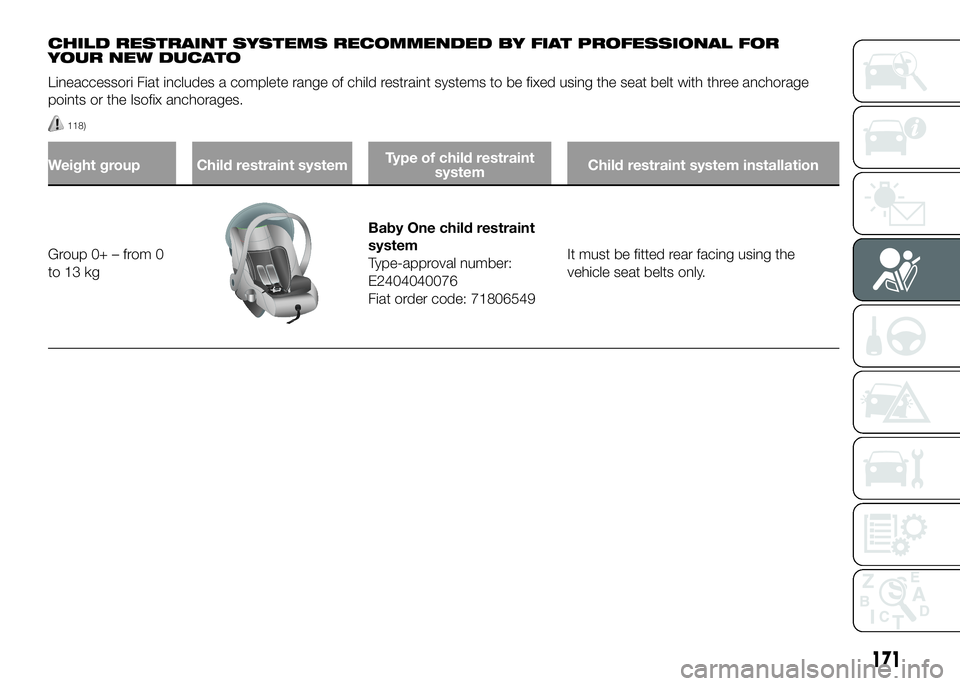
CHILD RESTRAINT SYSTEMS RECOMMENDED BY FIAT PROFESSIONAL FOR
YOUR NEW DUCATO
Lineaccessori Fiat includes a complete range of child restraint systems to be fixed using the seat belt with three anchorage
points or the Isofix anchorages.
118)
Weight group Child restraint systemType of child restraint
systemChild restraint system installation
Group 0+ – from 0
to13 kg
Baby One child restraint
system
Type-approval number:
E2404040076
Fiat order code: 71806549It must be fitted rear facing using the
vehicle seat belts only.
171
Page 176 of 387
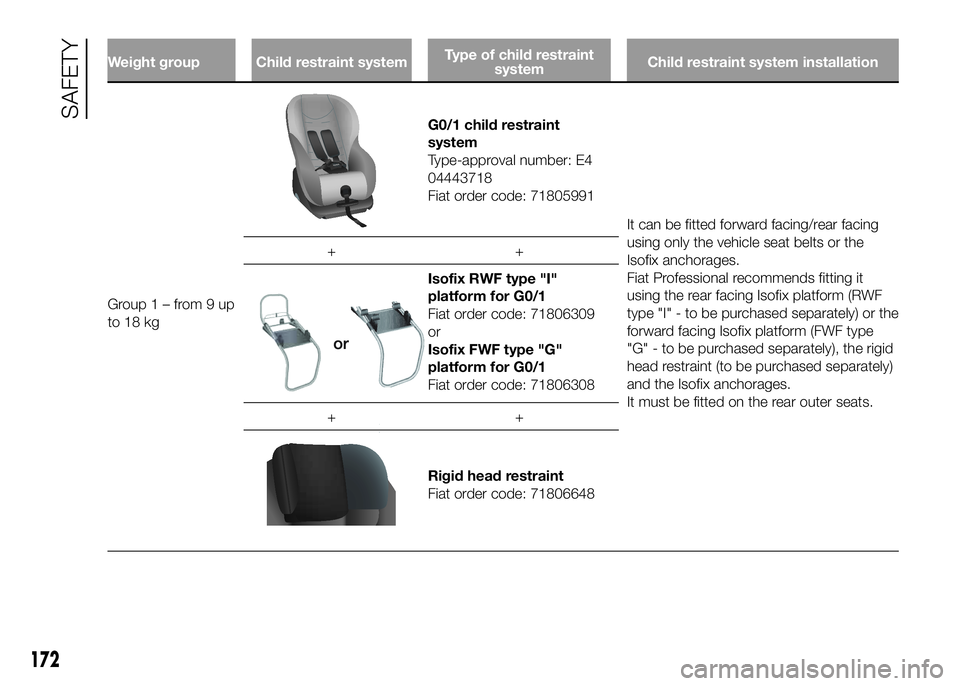
Weight group Child restraint systemType of child restraint
systemChild restraint system installation
Group1–from9up
to 18 kg
G0/1 child restraint
system
Type-approval number: E4
04443718
Fiat order code: 71805991
It can be fitted forward facing/rear facing
using only the vehicle seat belts or the
Isofix anchorages.
Fiat Professional recommends fitting it
using the rear facing Isofix platform (RWF
type "I" - to be purchased separately) or the
forward facing Isofix platform (FWF type
"G" - to be purchased separately), the rigid
head restraint (to be purchased separately)
and the Isofix anchorages.
It must be fitted on the rear outer seats. ++
Isofix RWF type "I"
platform for G0/1
Fiat order code: 71806309
or
Isofix FWF type "G"
platform for G0/1
Fiat order code: 71806308
++
Rigid head restraint
Fiat order code: 71806648
172
SAFETY
Page 177 of 387
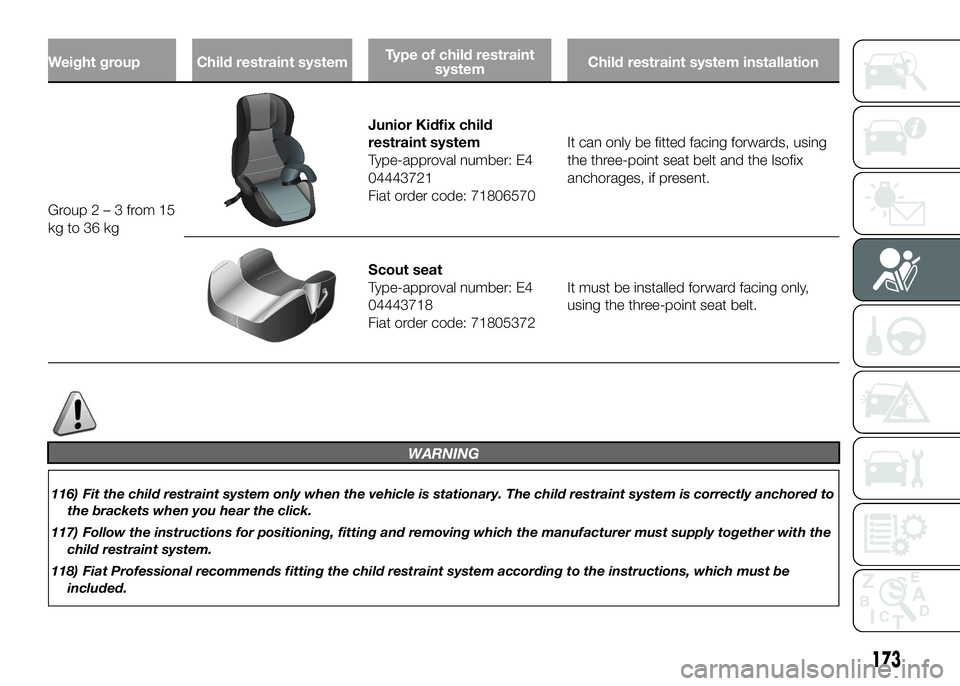
Weight group Child restraint systemType of child restraint
systemChild restraint system installation
Group2–3from15
kg
to 36 kg
Junior Kidfix child
restraint system
Type-approval number: E4
04443721
Fiat order code: 71806570It can only be fitted facing forwards, using
the three-point seat belt and the Isofix
anchorages, if present.
Scout seat
Type-approval number: E4
04443718
Fiat order code: 71805372It must be installed forward facing only,
using the three-point seat belt.
WARNING
116) Fit the child restraint system only when the vehicle is stationary. The child restraint system is correctly anchored to
the brackets when you hear the click.
117) Follow the instructions for positioning, fitting and removing which the manufacturer must supply together with the
child restraint system.
118) Fiat Professional recommends fitting the child restraint system according to the instructions, which must be
included.
173
Page 178 of 387
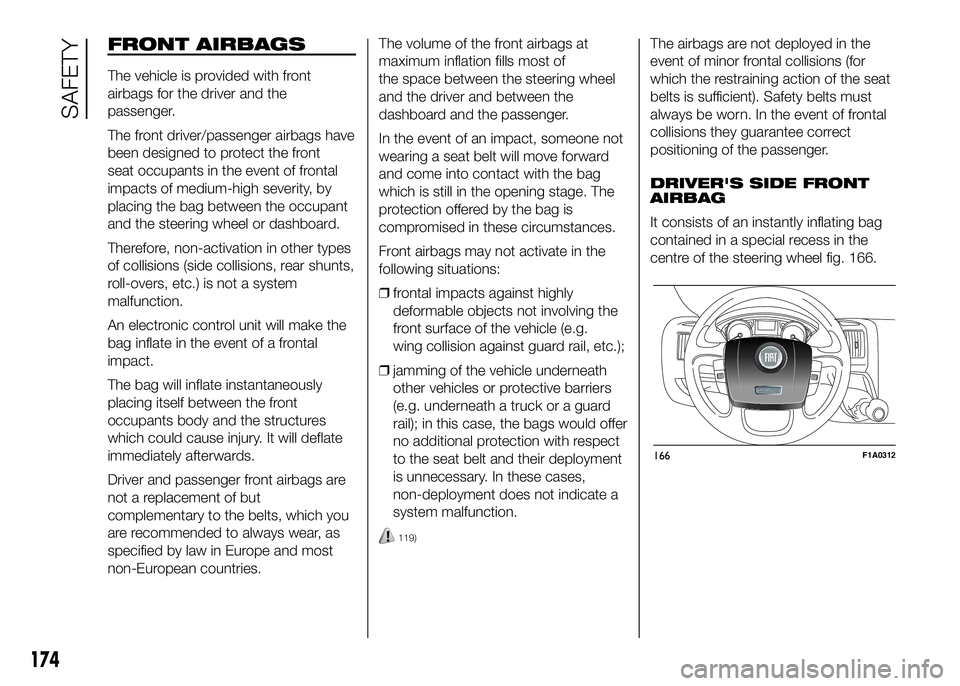
FRONT AIRBAGS
The vehicle is provided with front
airbags for the driver and the
passenger.
The front driver/passenger airbags have
been designed to protect the front
seat occupants in the event of frontal
impacts of medium-high severity, by
placing the bag between the occupant
and the steering wheel or dashboard.
Therefore, non-activation in other types
of collisions (side collisions, rear shunts,
roll-overs, etc.) is not a system
malfunction.
An electronic control unit will make the
bag inflate in the event of a frontal
impact.
The bag will inflate instantaneously
placing itself between the front
occupants body and the structures
which could cause injury. It will deflate
immediately afterwards.
Driver and passenger front airbags are
not a replacement of but
complementary to the belts, which you
are recommended to always wear, as
specified by law in Europe and most
non-European countries.The volume of the front airbags at
maximum inflation fills most of
the space between the steering wheel
and the driver and between the
dashboard and the passenger.
In the event of an impact, someone not
wearing a seat belt will move forward
and come into contact with the bag
which is still in the opening stage. The
protection offered by the bag is
compromised in these circumstances.
Front airbags may not activate in the
following situations:
❒frontal impacts against highly
deformable objects not involving the
front surface of the vehicle (e.g.
wing collision against guard rail, etc.);
❒jamming of the vehicle underneath
other vehicles or protective barriers
(e.g. underneath a truck or a guard
rail); in this case, the bags would offer
no additional protection with respect
to the seat belt and their deployment
is unnecessary. In these cases,
non-deployment does not indicate a
system malfunction.
119)
The airbags are not deployed in the
event of minor frontal collisions (for
which the restraining action of the seat
belts is sufficient). Safety belts must
always be worn. In the event of frontal
collisions they guarantee correct
positioning of the passenger.
DRIVER'S SIDE FRONT
AIRBAG
It consists of an instantly inflating bag
contained in a special recess in the
centre of the steering wheel fig. 166.
166F1A0312
174
SAFETY
Page 179 of 387
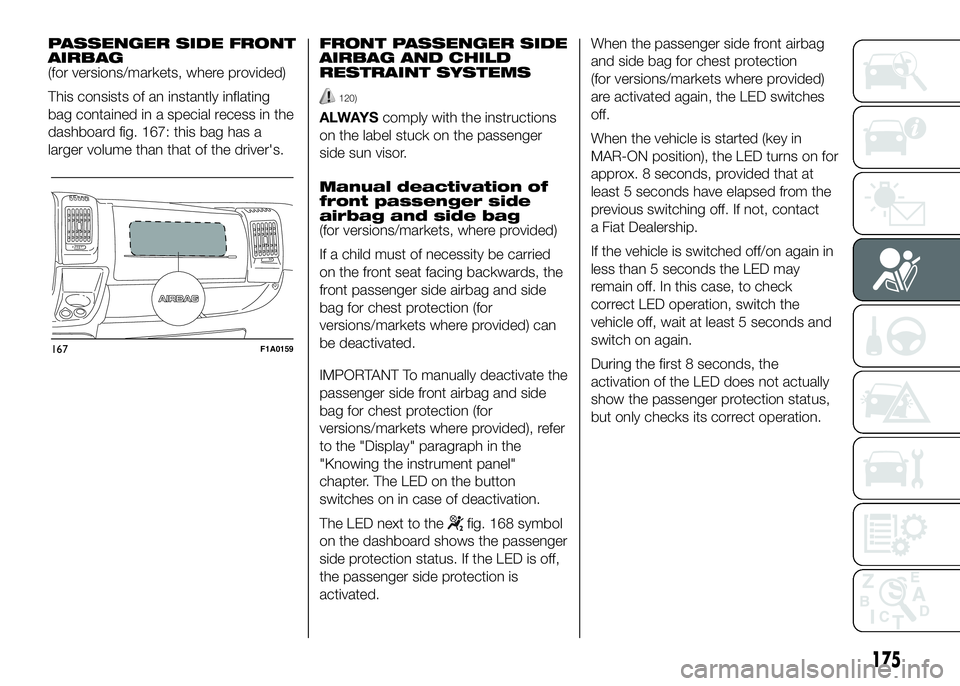
PASSENGER SIDE FRONT
AIRBAG
(for versions/markets, where provided)
This consists of an instantly inflating
bag contained in a special recess in the
dashboard fig. 167: this bag has a
larger volume than that of the driver's.FRONT PASSENGER SIDE
AIRBAG AND CHILD
RESTRAINT SYSTEMS
120)
ALWAYScomply with the instructions
on the label stuck on the passenger
side sun visor.
Manual deactivation of
front passenger side
airbag and side bag
(for versions/markets, where provided)
If a child must of necessity be carried
on the front seat facing backwards, the
front passenger side airbag and side
bag for chest protection (for
versions/markets where provided) can
be deactivated.
IMPORTANT To manually deactivate the
passenger side front airbag and side
bag for chest protection (for
versions/markets where provided), refer
to the "Display" paragraph in the
"Knowing the instrument panel"
chapter. The LED on the button
switches on in case of deactivation.
The LED next to the
fig. 168 symbol
on the dashboard shows the passenger
side protection status. If the LED is off,
the passenger side protection is
activated.When the passenger side front airbag
and side bag for chest protection
(for versions/markets where provided)
are activated again, the LED switches
off.
When the vehicle is started (key in
MAR-ON position), the LED turns on for
approx. 8 seconds, provided that at
least 5 seconds have elapsed from the
previous switching off. If not, contact
a Fiat Dealership.
If the vehicle is switched off/on again in
less than 5 seconds the LED may
remain off. In this case, to check
correct LED operation, switch the
vehicle off, wait at least 5 seconds and
switch on again.
During the first 8 seconds, the
activation of the LED does not actually
show the passenger protection status,
but only checks its correct operation.
167F1A0159
175
Page 180 of 387
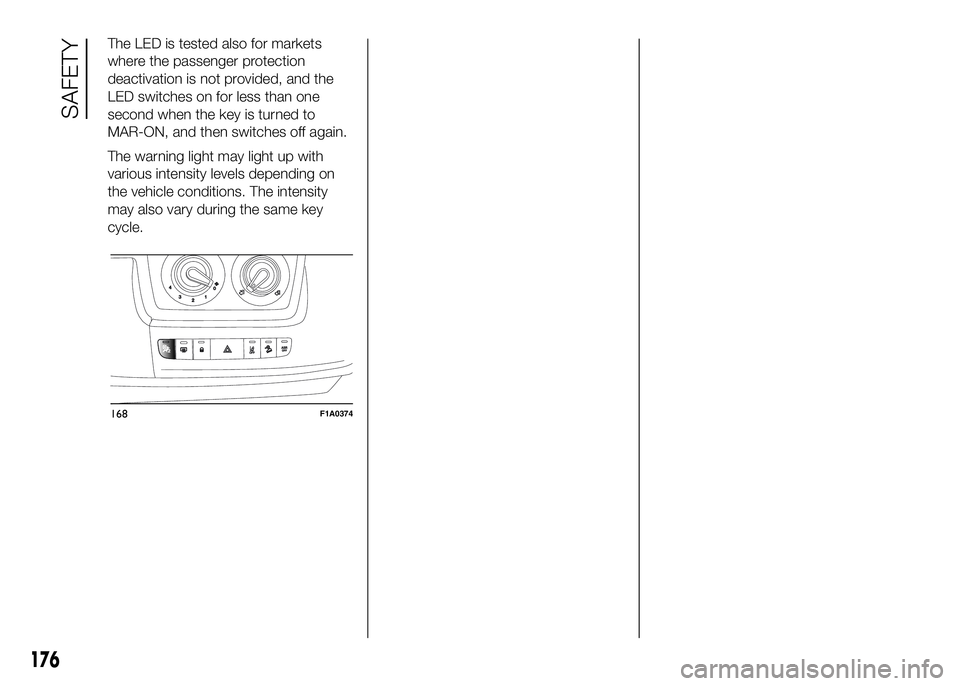
The LED is tested also for markets
where the passenger protection
deactivation is not provided, and the
LED switches on for less than one
second when the key is turned to
MAR-ON, and then switches off again.
The warning light may light up with
various intensity levels depending on
the vehicle conditions. The intensity
may also vary during the same key
cycle.
168F1A0374
176
SAFETY